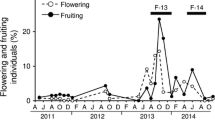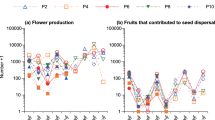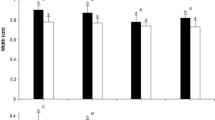Abstract
Variation in the occurrence and the intensity of pre-dispersal seed predation can help understand ecological and evolutionary dynamics of plant populations. Pre-dispersal seed predation can vary in intensity, resulting in costs that differ in magnitude among populations. We examined variation in the cost of pre-dispersal seed predation across nine Yucca schidigera populations, by quantifying yucca moth infestation, damage on fertile seeds and seed mass in 650 fruits sampled from 73 Yucca plants. We recorded Tegeticula mojavella larvae on 100% of the Y. schidigera plants. Across populations, mean infestation rates ranged from 2.9 to 6.11 larvae per fruit. Despite slight variation in the level of fruit infestation, predation on mature seeds differed among the nine populations, ranging from 10 to 26%. Mean seed mass and germination rate differed among populations, but the effect of larvae infestation on these traits was not significant. Altogether, our results demonstrate that infestation and pre-dispersal seed predation by yucca moths differ significantly across populations of Y. schidigera. Variable ratios of seed predation result in different costs across plant populations, despite experiencing similar infestation ratios. It seems that, regardless of its spatial distribution, the interaction between Y. schidigera and T. mojavella is dependent on local ecological factors that regulate oviposition and seed predation.

(modified from Turner et al. 2005)

Similar content being viewed by others
Data availability
Our dataset is available using the https://doi.org/10.6084/m9.figshare.7215014
References
Addicott JF (1986) Variation in the costs and benefits of mutualism: the interaction between yuccas and yucca moths. Oecologia 70:486–494
Althoff DM, Segraves KA, Leebens-Mack J, Pellmyr O (2006) Patterns of speciation in the Yucca moths: parallel species radiations within the Tegeticula yuccasella species complex. Syst Biol 55:398–410
Ashman T-L, Knight TM, Steets JA, Amarasekare P, Burd M, Campbell DR, Dudash MR, Johnston MO, Mazer S, Mitchell RJ, Morgan MT, Wilson WG (2004) Pollen limitation of plant reproduction: ecological and evolutionary causes and consequences. Ecology 85:2071–2081
Baer KC, Maron JL (2018) Pre-dispersal seed predation and pollen limitation constrain population growth across the geographic distribution of Astragalus utahensis. J Ecol 106:1646–1659
Baldwin BG, Goldman DH, Keil DJ et al (eds) (2012) The Jepson manual: vascular plants of California. The University of California Press, Berkeley
Bello-Bedoy R, Cruz LL, Núñez-Farfán J (2011) Inbreeding alters a plant-predispersal seed predator interaction. Evol Ecol 25:815–829
Borchert MI, DeFalco LA (2016) Yucca brevifolia fruit production, predispersal seed predation, and fruit removal by rodents during two years of contrasting reproduction. Am J Bot 103:830–836. https://doi.org/10.3732/ajb.1500516
Bronstein JL (2001) The costs of mutualism. Am Zool 41:825–839
Bronstein JL, Ziv Y (1997) Costs of two non mutualistic species in a yucca/yucca moth mutualism. Oecologia 112:379–385
Castillo G, Cruz LL, Tapia-López R et al (2014) Selection mosaic exerted by specialist and generalist herbivores on chemical and physical defense of Datura stramonium. PLoS ONE 9:e102478
Csotonyi JT, Addicott JF (2001) Competition between mutualists: the role of differential flower abscission in yuccas. Oikos 94:557–565
Dimitri LA, Longland WS, Tonkel KC, Rector BG, Kirchoff VS (2018) Impacts of granivorous and frugivorous arthropods on pre-dispersal seed production of western juniper (Juniperus occidentalis). Arthropod Plant Interact 12:465–476
Dodd RJ, Linhart YB (1994) Reproductive consequences of interactions between Yucca glauca (Agavaceae) and Tegeticula yuccasella (Lepidoptera) in Colorado. Am J Bot 81:815–825
Farrell BD, Mitter C, Futuyma DJ (1992) Diversification at the insect-plant interface. Bioscience 42:34–42
Fick SE, Hijmans RJ (2017) WorldClim 2: new 1-km spatial resolution climate surfaces for global land areas. Int J Climatol 37:4302–4315
González-Abraham C, Garcillán P, Ezcurra E (2010) Ecorregiones de la península de Baja California: Una síntesis. Boletín la Soc Botánica México 82:69–82
Han YJ, Baskin JM, Tan DY et al (2018) Effects of predispersal insect seed predation on the early life history stages of a rare cold sand-desert legume. Sci Rep 8:3240–3250
Harrower J, Gilbert GS (2018) Context-dependent mutualisms in the Joshua tree–yucca moth system shift along a climate gradient. Ecosphere 9:e02439
Huth CJ, Pellmyr O (2000) Pollen-mediated selective abortion in Yuccas and its consequences for the plant-pollinator mutualism. Ecology 81:1100–1107
Kato M, Kawakita A (2017) Obligate pollination mutualism, ecological research monographs. Springer, Japan
Katz DSW (2016) The effects of invertebrate herbivores on plant population growth: a meta-regression analysis. Oecologia 182:43–53
Keeley JE, Keeley SC, Swift CC, Lee J (1984) Seed predation due to the Yucca-Moth symbiosis. Am Midl Nat 112:187–191
Kolb A, Ehrlén J, Eriksson O (2007) Ecological and evolutionary consequences of spatial and temporal variation in pre-dispersal seed predation. Perspect Plant Ecol Evol Syst 9:79–100
Koptur S (1998) Effect of seed damage on germination in the common vetch (Vicia sativa L.). Am Midl Nat 140:393–396
Leimu R, Lehtilä K (2006) Effects of two types of herbivores on the population dynamics of a perennial herb. Basic Appl Ecol 7:224–235
Leimu R, Syrjänen K, Ehrlén J, Lehtilä K (2002) Pre-dispersal seed predation in Primula veris: among-population variation in damage intensity and selection on flower number. Oecologia 133:510–516
Marr DL, Pellmyr O (2003) Effect of pollinator-inflicted ovule damage on floral abscission in the yucca-yucca moth mutualism: the role of mechanical and chemical factors. Oecologia 136:236–243
Marr DL, Leebens-Mack J, Elms L, Pellmyr O (2000) Pollen dispersal in Yucca filamentosa (Agavaceae): the paradox of self-pollination behavior by Tegeticula yuccasella (Prodoxidae). Am J Bot 87:670–677
Molau U, Eriksen B, Knudsen JT (1989) Predispersal seed predation in Bartsia alpina. Oecologia 81:181–185
Pellmyr O (1999) Systematic revision of the yucca moths in the Tegeticula yuccasella complex (Lepidoptera: Prodoxidae) north of Mexico. Syst Entomol 24:243–271
Pellmyr O, Huth CJ (1994) Evolutionary stability of mutualism between yuccas and yucca moths. Nature 372:257–260
Pellmyr O, Leebens-Mack J (2000) Reversal of mutualism as a mechanism for adaptive radiation in yucca moths. Am Nat 156:S62–S76
Pellmyr O, Balcázar-Lara M, Segraves KA et al (2008) Phylogeny of the pollinating yucca moths, with revision of Mexican species (Tegeticula and Parategeticula; Lepidoptera, Prodoxidae). Zool J Linn Soc 152:297–314
Riley CV (1892) The yucca moth and yucca pollination. Third Annual Report of the Missouri Botanical Garden.
Shapiro J, Addicott JF (2004) Re-evaluating the role of selective abscission in moth/yucca mutualisms. Oikos 105(3):449–460
Skoracka A, Lewandowski M, Rector BG, Szydlo W, Kuczyński L (2017) Spatial and host-related variation in prevalence and population density of wheat curl mite (Aceria tosichella) cryptic genotypes in agricultural landscapes. PLoS ONE 12:1–17
Thompson JN (2005) The geographic mosaic of coevolution. The University of Chicago Press
Thompson JN, Cunningham BM (2002) Geographic structure and dynamics of coevolutionary selection. Nature 417:735–738
Toju H, Sota T (2006) Imbalance of predator and prey armament: geographic clines in phenotypic interface and natural selection. Am Nat 167:105–117
Turner RM, Bowers JE, Burgess TL (2005) Sonoran Desert plants: an ecological atlas. University of Arizona Press
Warton DI, Hui FKC (2011) The arcsine is asinine: the analysis of proportions in ecology. Ecology 92:2049–2055
Weber MG, Agrawal AA (2014) Defense mutualisms enhance plant diversification. Proc Natl Acad Sci 111:16442–16447
Wilson RD, Addicott JF (1998) Regulation of mutualism between yuccas and yucca moths: is oviposition behavior responsive to selective abscission of flowers? Oikos 81:109–118
Ziv Y, Bronstein JL (1996) Infertile seeds of Yucca schottii: a beneficial role for the plant in the yucca-yucca moth mutualism? Evol Ecol 10:63–76
Acknowledgements
This manuscript constitutes a partial requirement for the doctoral dissertation of L. De la Rosa-Conroy at the Life Sciences Graduate Program in CICESE. We thank Sula Vanderplank, PhD for helpful comments on an earlier version of this manuscript, and E. López and M. Salazar for assisting with sample collection. We also thank Juan Cons and the students at Genética Ecológica Lab (UABC) and Genética de la Conservación Lab (CICESE) for participating in fieldwork and fruit dissections during 2015–2018.
Funding
Dr. Maria Clara Arteaga received funding from CONACYT (Project No. CB-2014-01-238843) and CICESE (Project No. 681-114); Dr. Rafael Bello-Bedoy received funding from CONACYT (Project No. INFRA2015_226239); and Leonardo De la Rosa-Conroy received a doctoral scholarship from CONACYT (Grant No. 19713).
Author information
Authors and Affiliations
Contributions
All authors contributed equally to the preparation of this manuscript. MCA directed the project, MCA and RBB conceived the study, LDC and RBB contributed with sample collection and data analysis, LDC and RBB wrote the first draft of the manuscript, and MCA, SBH, and LEF contributed with the overall preparation of the manuscript and with interpretation of the results.
Corresponding author
Ethics declarations
Conflict of interest
The authors declare that they have no conflicts of interest.
Additional information
Communicated by Philip Ladd.
Publisher's Note
Springer Nature remains neutral with regard to jurisdictional claims in published maps and institutional affiliations.
Rights and permissions
About this article
Cite this article
De la Rosa-Conroy, L., Arteaga, M.C., Bullock, S.H. et al. Population variation in the intensity of fruit infestation and pre-dispersal seed predation in Yucca schidigera (Asparagaceae) by its obligate pollinator. Plant Ecol 220, 711–720 (2019). https://doi.org/10.1007/s11258-019-00946-9
Received:
Accepted:
Published:
Issue Date:
DOI: https://doi.org/10.1007/s11258-019-00946-9




